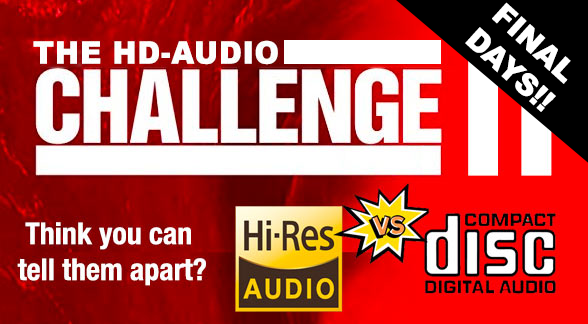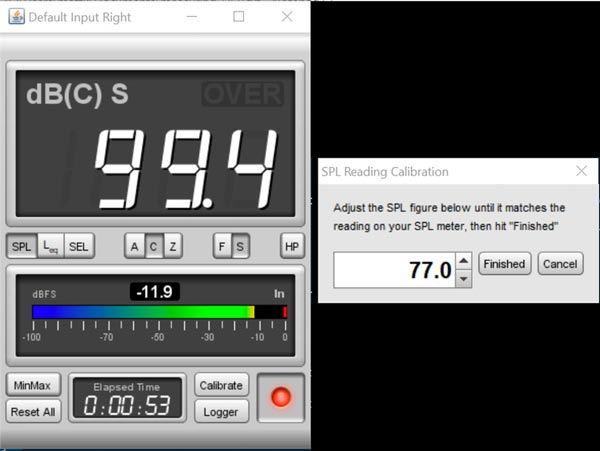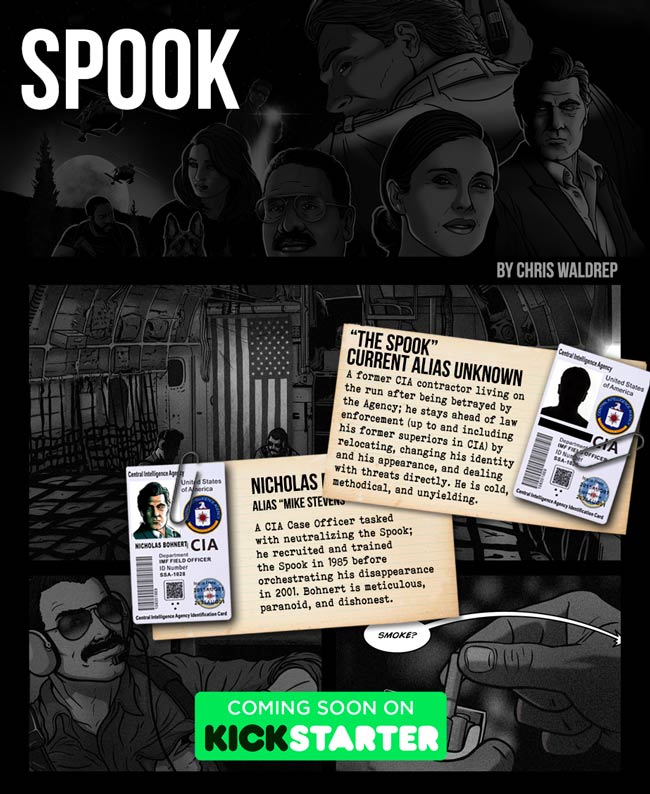Cable Denial or Deaf Faith?
My sabbatical is officially over. I returned to the classroom last Tuesday to teach Advanced Audio Recording and Strategies for Media Production. I’ve enjoyed being away from the campus, traveling to a couple of trade shows, working on my websites, and conducting the HD-Audio Challenge II survey over these past 8 months but I’m actually glad to get back in front of a group of students.
HD-Audio Challenge II Update
I was granted a sabbatical after submitting a proposal to research the perceptibility of high-resolution audio. The fundamental question I (and undoubtedly others) want answered is whether audio consumers can identify a high-resolution music track by simply comparing a native 96 kHz/24-bit PCM (an AIX Records audiophile track) recording to a downconverted 44.1/16-bit Red Book CD version of the same recording. Over 1500 individuals requested access to the files, 300 have confirmed receipt, and 200 people have submitted their results. I’m thrilled at the level of participation and want to thank everyone for your time.

The initial period of the survey will be ending soon. I won’t be closing down the site or stop sending the soundfiles to new participants…the more people that get involved in this study the better. However, I have to submit a post sabbatical report to the university AND I plan to submit an article for consideration by the editors of the AES Journal. I have no idea whether they will be interested in the results of my research. It may not reach their scientific standards, but I think the information contributes to the issue. I will provide the correct answers to all participants and to the public soon.
So, if you haven’t yet asked to participate, downloaded the files, done some comparative listening, and submitted your selections, PLEASE take this opportunity to sign up and submit your results. I would like to especially encourage anyone under the age of 40 to take the challenge. It seems most of those that have submitted the final form are somewhat older. It would be great to get some younger ears involved.
You can sign up using the form below:
An Outlier Submission
I regularly collect any new submissions to the HD-Audio Challenge and append them to the master spreadsheet. And I glance at the raw statistics and percentages calculated by the spreadsheet. I’ve already got a pretty good idea of how most people are doing so it was somewhat surprising that one particular individual got 19 out of 20 correct! A 69-year old gentleman did way better than every other submission. I was surprised and naturally somewhat suspicious. There had to be a reason.
So I read his listening notes and there was the answer. He wrote:
“Comparison of A/B several times, taking a specific part with higher dynamics (15-20 seconds) and choose the one with the highest peak level which is given on JRiver DSP Studio Analyser shown during playback.
I used realtime switching between tracks comparing the peak level of 15-20 sec parts with higher dynamics.
In fact the determination of HR version by listening parts of the track and comparing A/B was confirmed or decided by the highest peak level if i could not hear any difference.“
He had ignored my requirement to use ONLY your ears to make a choice. He relied on the JRiver DSP Studio Analyzer to show which instantaneous peak was higher. As much as I tried to match the two versions of the files, they are different by about .1 dB, enough for the peak and hold metering of the software player to show.

So I wrote to him and explained the issue. He acknowledged that he had employed a “tool” as an aid in making his selections and offered to repeat the process. I scrambled the filenames and let him have another chance. I’m still waiting for the second round.
At the risk of encouraging others to employ “tools”, I mention this story because the survey is only as valid as the participants are honest. Please limit yourselves to listening only.
Cable Nonsense
What is it that Art Linkletter used to say? Kids say the darndest things. Well, it seems some FB audio group administrators, audiophiles, high-end audio salespersons, audiophile society officials, and manufacturers also say things that make little or no sense when talking or posting about cables.
I usually steer clear of FB posts or online magazines that promote high-end audio cables. It’s just never safe to present with science, established electrical engineering theory and practice, or objectiveness when cables are concerned. A recent exchange on a familiar FB audio group page resulted in a member calling me a “cable denier” because I advocated for science and physics in evaluating power cords.
The thread basically dismissed my comments because I’m a member of the professional audio engineering community. Audio equipment salespeople, FB administrators, high-end audio marketing managers, and the general audio buying public are claimed to be better and more reliable sources of information when it comes to recommending expensive accessories and cables. According to the gentleman below, they are capable of listening in ways that audio professionals can not.
One commenter wrote:
“Mark is a pro and speaks just like one, but he is not a professional LISTENER, like you (Writer’s NOTE: the guy offering the ultra expensive power cords), I and so many others in the high-end industry. Interesting is that most so-called experts are also naysayers who work in the recording industry, not in the high-end industry.”
What does this statement actually claim? That professional audio engineers and producers do not know how to listen? That spending one’s professional life in front of speakers in a control room doesn’t require listening?Maybe…just maybe…the engineers responsible for producing the recordings that are played back in these guys high-end systems are correct in their assessment of power cords and expensive USB/Ethernet cables. Image that!
Can you really trust a gentlemen that just launched a new cable company that offers a 6-foot power cord for $3150? Oh and this person also believes that cables are directional! BTW They are not.
Here’s a couple of additional comments…
“Cables can make a difference. I’m glad I can hear those differences it truly enhances the experience. I have been a dedicated audiophile and in the industry for over 45 years and have been able to identify those differences since my first experience with Smog Lifters in the 70’s. I search for and usually discover great products that deserve special attention by people looking for the last bit of resolution and coherency. I’m truly sorry for those that wouldn’t hear the difference.”
Here’s a comment from an individual that swapped a normal Ethernet cable for an expensive one.
“…the Vodka seemed to remove a layer of film for superior textural reveal. There was also a shade more tonal depth and recording space ‘air’. Most noticeable of all was a further uptick in micro-dynamic jump.”
I don’t know about you but I cringe when I hear people talk about audio in such terms. And this after listening to a commercial album and then stopping, swapping the cable and relistening. It’s unbelievable.
I could pull quotes from cable reviews all afternoon but I think you get the point. When anyone starts spewing nonsense about power cords, digital interconnects, or network cables, run away. Keep your wallet in your pocket and unsubscribe from that group or online magazine. Their motivations are suspect. They either want to sell you something (usually at very high cost) or are dependent on advertising dollars from the companies they write about or the individuals they interview.
Another User Guide Is Coming!
I checked the sign up form for my next book and was encouraged to see over 250 people have expressed interest in A User Guide to Streaming, Downloads, and Personal Audio. I’ve started researching and writing the next book and will be launching the Kickstarter campaign in a couple of months. The plan is to finish the book by the end of the year. The emergence of high quality streaming as a major aspect of our listening ecosystem is the catalyst for this project. Stay tuned. If you would like to add you name to the mailing list for launch day discounts and other special offers, please visit the website at http://www.sdpaguide.com/. Thanks.

SPOOK Website Is Now Live!
I mentioned the project my son has been working on for about 3 years. It’s a 3 volume, 30 episode graphic novel about a former CIA Agent. I would encourage all readers to check out the project website, sign up to the mailing list, and help promote a soon to be announced Kickstarter campaign. Visit https://www.spookofficial.com/ for additional information and to sign up.

Thanks.


I think he meant the “vodka” instead of the “Vodka”.
Cables do make a difference: they are a useful litmus test for snake oil. if you see a magazine, publication or manufacturer making effusive praise of expensive cables, you know they are hucksters and should be avoided like the plague. It’s odd you only see that level of mendacity in Hi-Fi, not in other similar hobbies like photography.
Thanks…I like your way of evaluating the sources that spew the misinformation on cables. I just stopped by PFO and read a article that claims the author “proves” cables make a difference. Funny, that the publication would allow a blatant ad for his own companies expensive cables. It’s really sad.
Cables can actually change the sound, but it’s either the volume level or the frequency response. Even hardcore objectivists like Ethan Winer and The Audio Critic have shown this (I would be happy to provide links), and someone on Hydrogen Audio also succesfully ABX’ed a set of speaker cables. He then subsequently measured the frequency response of his speakers with the two different cables, and there was a big difference.
So, buying expensive cables, if they do actually change the volume level or the frequency response, is like buying an equalizer or paying to turn the volume knob.
However, my impression is that as long as cables are properly made and are not too long, it’s highly unlikely that the volume level or the frequency response would ever be affected within audibility, but this is something that someone with more expertise than I would be able to explain in more detail.
I have decent cables, but I have also tried more expensive ones, even the stupid expensive power cords, and I couldn’t hear a difference and saw no reason to shell out more money. Then one of the sellers essentially called me a moron for not being able to hear a difference. And of course with that kind of customer service I’ve been back to that shop plenty of times since that day.
I’ve been called a moron as well for pointing out the cold hard facts about various types of cables. One vendor told me my system wasn’t up to par (a room worth $250,000 and which has been used to master bands like the Allman Brothers, Bad Company, The Nitty Gritty Dirt Band, and The San Francisco Symphony!!), my hearing is failing, or I refuse to acknowledge it. I can take the criticism. I’ve pointed out the clearly fraudulent “tricks” that vendors use to highlight their cables and I’ve challenged anyone to show me that identical digital data from two cables can alter the reproduced sound…they haven’t been able to explain it yet. Power cords and fancy digital USB cables do not — and should not — change the volume level of the output stages. Nor should they alter the frequency response. Some amateurs might like to think that cables be used as equalizers but professionals do not. I will acknowledge that some cables in rare circumstances of especially long runs can minimally affect higher frequencies. But any change in fidelity pales in comparison to moving your head slightly in a poorly or untuned room. The cable people are bilking the audiophile community and they know. When challenges after a post of mine that exposed the nonsense of power cords, a high profile cable company threatened a lawsuit. Thanks to a friendly attorney, they backed off when we welcomed the chance to have them demonstrate an amplitude change by swapping a standard IEC power cord for one of their $6000 fancy ones. They graciously declined the opportunity to do their demo in a courtroom. Why? Because power cords don’t change volume or frequency response.
good video on cables here… https://www.youtube.com/watch?v=VlYjQBTx-rs
audioholics shares your opinion.
Hi, Mark.
Boy, did you start a firestorm with the Hi-Res audio thing. I enjoy reading posts by people who don’t know what they are talking about (all the extra bits in hi-res audio go below -96dB!) for a few minutes, but then realize that I could be doing something important like watching cat videos on YouTube.
As to cables the thing that nobody ever really speaks about is this: it’s not really what the cables are adding to the system, but what they aren’t adding. EMI noise being the big culprit.
Making sure that all of the cables (other than speaker cables) in your system are fully shielded is really key to achieving optimal performance. Proper looming of the cables helps as does keeping them as short as reasonably possible. With speaker cabling, using a star-quad config can pay dividends under certain circumstances.
Also, the reason I use a power conditioner is not for it’s magical qualities, but because most power supplies in A/V equipment are not very good. They don’t filter out power line noise well and certainly aren’t up to surviving a lightning strike surge.
I’m going to be upgrading the amp powering the front stereo speakers in my home theater to Benchmark’s AHB-2 (my theater is my main audio system). It is the best amp in the world.
I asked them whether whether I should use a power conditioner. The answer was, “No.” I then got back and asked about the lightning surge scenario. The answer? “No, you should be fine.”
Now that is a power supply.
Jeff, thanks for the comments. There is a lot of confusion in the audio world…much of it perpetuated by vendors selling pricey products of questionable value. Cables are a prime example. I make the assumption that audiophiles know to purchase properly shielded cables but shelling out thousands of dollars for a short power cord or USB digital interconnect is just plain wrong. I would disagree that most audiophile equipment power supplies are “not very good”. It depends on the designer/manufacturer. Kudos on the Benchmark AHB-2. I am good friends with the folks at Benchmark and have used their equipment for years…including the AHB-2s.
There is nothing like the ire raised when you dispel myths like $60,000 speaker cables with mystery boxes that have four knobs on the front actually do anything besides transfer wealth. Of all the ludicrous things you see offered to people in the audio world this one tops the bill for snake oil.
If a power cable improves the sound of an audio component it strikes me that the power supply of the audio component was poorly designed or is broken. The power supply has two functions: 1) Convert input voltage to the correct voltage needed by the audio circuits and 2) filter the supplied power to ensure it has negligible noise. The best person to define “negligible” is the designer of the audio circuits. People with high end amplifiers, preamps, CD drives, turntables, etc., who claim a power cable noticeably improved the sound are basically saying that the power supply of that component was poorly designed or damaged. If the power supply was poorly designed what does it say about the design of the rest of the component?
I am an amateur musician, and my system is very resolutive. I own several not-very-expensive power cables, from Oyaide, Supra, Rega, and PS Audio. I purchased some new, some used, and some from a friend.
When I put the cables in my system I can hear differences, especially in some of the components. I will not dare to try to describe the sound, but enough to say that some of them fit my taste better than others. I know very well how my system sounds and can notice these subtleties.
I am not defending super-expensive cables, but I cannot deny my ears.